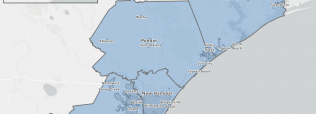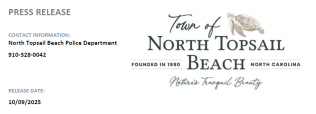Terminal Groins FAQ
Many residents and property owners in town have strong
opinions about the possibility that a terminal groin will be
constructed at the New River Inlet, as well as the cost of
such a project. This FAQ sheet will try to give background on
terminal groins and the situation in North Topsail Beach.
Question: What is a terminal groin?
Answer: A terminal groin is a hardened structure placed at a
right angle out into the ocean at the terminus – beginning -
of an inlet or a spit of shoreline to slow the rate of shoreline
erosion. The image above is the terminal groin (black line
extending out into the ocean) built in 1961 at Fort Macon State Park to protect the Civil War fort from erosion.
It still functions as intended today.
Question: What is the difference between a terminal groin and a jetty?
Answer: Jetties normally come in pairs on either side of an inlet or channel in order to protect shoaling (sand
bars) from developing in the shipping or boating channel. They are generally built higher than the water at
high tide.
A terminal groin, on the other hand, is a single structure constructed to allow the high tide or storm waves to
wash over the top of the groin. Large stones used in construction allow ocean water to pass through the groin,
but at a much slower rate, so sand is trapped on the ocean side of the groin to preserve the beach.
Question: How did terminal groins come to be considered for erosion control in NC?
Answer: In North Carolina, the state legislature considers terminal groins experimental structures and is only
allowing for the possible construction of six of them. To date only one - at Bald Head Island - has been
constructed. Recently, the town of Ocean Isle Beach was granted a permit to construct a terminal groin at the
east end of town adjoining Shallotte Inlet.
Question: What happened in the past that suggested a terminal groin would slow erosion at the New River
Inlet?
Answer: Starting around 2002, the town hired a coastal engineering firm to study the erosion problem at the
inlet. This was after the oceanfront from the inlet south to past the St. Regis began experiencing high rates of
erosion. The firm offered two alternatives. The first was a realignment of the New River Inlet Channel. The
second was construction of a terminal groin.
The board at that time opted for inlet realignment, as that was the least expensive and quickest alternative to
attempt to save structures and infrastructure. In 2005 Hurricane Ophelia hit and exacerbated erosion near the
inlet, leading to the removal of a row of eight oceanfront duplexes. It was not until 2012, after receiving all
permits and approvals, dredged sand from the realigned segment was placed onto the Phase 1 beach that
winter. Most of that sand eroded away over the next 18 months, resulting in emergency board action to
construct a sand bag revetment to protect the remaining oceanfront buildings and town infrastructure.
Because the inlet realignment failed to adequately slow erosion in the inlet area, the town’s remaining alternative was a terminal groin.
Question: Have past or present NTB Boards of Aldermen voted to construct a terminal groin?
Answer: Emphatically, NO. It was a recommendation for the town to explore. The town hired an environmental engineering firm to develop an Environmental Impact Statement (EIS) that includes a terminal groin, as well as other alternatives to be evaluated. The timeline for the completion of the EIS process is 10-12 years. It is unlikely that the town board will be able to vote on whether or not to approve seeking permitting for a terminal groin for several more years.
Question: What is process and timeline for potential approval of a terminal groin?
Answer: In 2016 the town hired an environmental engineering firm to develop an EIS for the US Army Corps of Engineers (USACE) that would look at alternatives, including a terminal groin, to slow erosion at the New River Inlet. In 2019, the USACE completed a third-party agreement with the town authorizing an environmental engineering firm to serve as an independent contractor to review the EIS with a preferred option of a terminal groin and then make recommendations to the USACE.
In the meantime, the USACE must conduct several interagency scoping meetings and reviews, as well as public comment periods (the first one was held March 25, 2021). The meetings give all federal and North Carolina environmental agencies a preview of the Preliminary Draft EIS in preparation for each agency’s review. Agency reviews can take two months or more. From those reviews a Draft EIS will be developed and include the concerns raised by the various agencies. The Draft EIS then has to go through the same review processes. Once the Draft EIS reviews are in, a Final EIS is prepared and, again, must go through all the stages of review.
When the Final EIS is reviewed by the USACE, a decision will be made to release the Final EIS, which may allow the town to seek a state permit for a terminal groin. Additionally, once the Final EIS is released public environmental groups that are opposed to terminal groins can take the USACE and town to court, a process that added about two years to Ocean Isle Beach’s timeline for terminal groin approval.
Ocean Isle Beach waited over 11 years from start to finish, including court challenges, to finally be able to seek bids for construction this year. We do not anticipate a shorter timeline for North Topsail Beach, but continue to encourage the USACE to stay on track with the over 35 program steps required to get to the Final EIS public release.
Question: What can the public do to have their opinions heard?
Answer: Be alert to the USACE announcements for public comments. The town website and Sunshine List will be used to make these time periods known. For now, the tentative timeline lists the next public comment period occurring in December but as of November the public comment period will likely be pushed back to Spring of 2022 to allow time for the interagency scoping meeting to be held in December.




